Excerpts from Jim Conrad's
Naturalist Newsletter
from the March 27, 2016 Newsletter issued from Hacienda Chichen Resort beside Chichén Itzá Ruins; limestone bedrock; elevation ~39m (~128ft), N20.675°, W88.569°; central Yucatán state, MÉXICO
TOBACCO
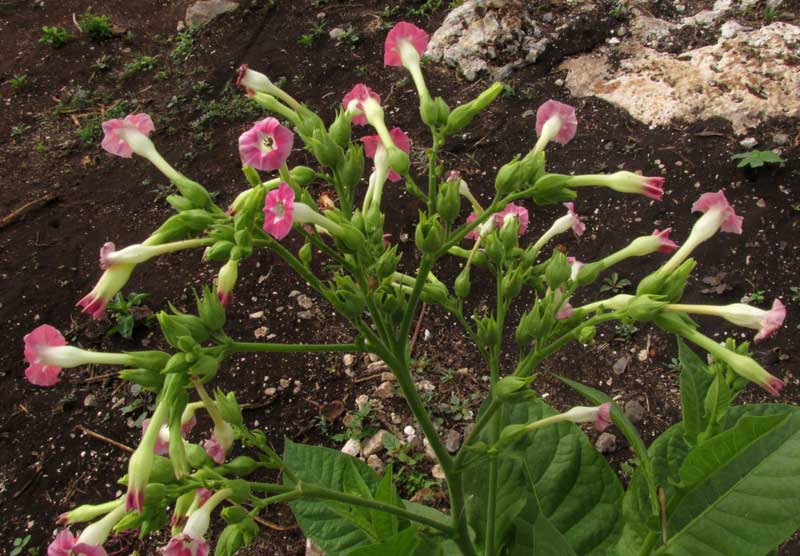
At the edge of Hacienda Chichen's organic garden a very familiar plant turned up, shown below:
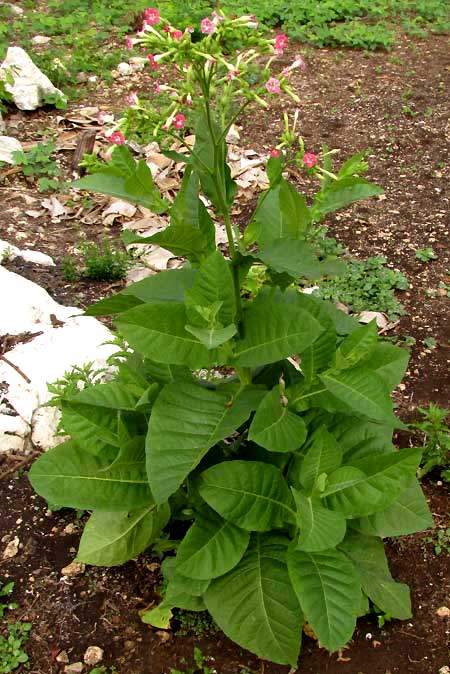
It was a Tobacco plant, NICOTIANA TABACUM, and it was familiar because I grew up on a tobacco farm in western Kentucky. As a kid I spent plenty of time setting, watering, hoeing, suckering, topping, cutting, and hanging tobacco in a barn. Back then I was thankful to go to school during fall's crisp days when the tobacco's "cured" leaves were tied into "hands" by my father and grandfather, and stacked along the barn's walls, later to be carried to market, to be auctioned. You can imagine the memories and associations that seeing that Tobacco plant brought to mind when I first saw it here, and how strange it felt seeing it next to the Hacienda's Papayas. However, Tobacco is native to the Americas and often I've seen it growing wild in Mexico.
This lone Tobacco plant next to our Papaya plantation was doing something I'd seldom seen the species do: It was bearing a full head of flowers, shown at the top of this page. A close-up of a flower is shown below:
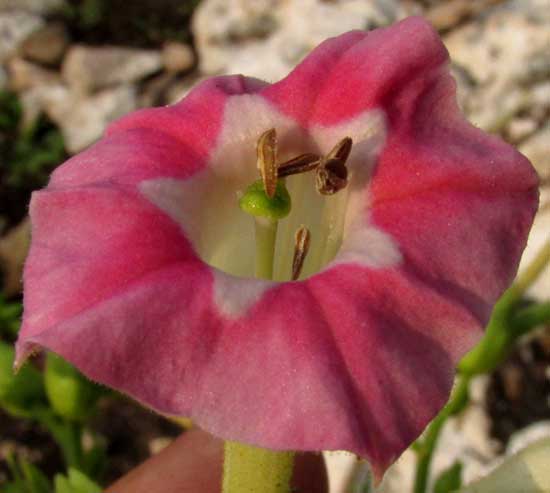
Back on the farm we never let our plants develop such flowering heads because as soon as the first flowers appeared we walked down every row in the field plucking the heads off. This upset the many Ruby-throated Hummingbirds and butterflies who craved the flowers' nectar, but we knew that if the flowers were allowed to grow, much of the plants' resources would be squandered on them and the subsequent fruits, not on the leaves that meant money to us. Below, you can see one of our garden plant's leaves:

Compared to leaves on our Kentucky plants, this Yucatan plant's blades were small, and I knew why. Not only had no one clipped off the flower clusters -- "topping" we called it -- but no one had "suckered" the plant, either. Suckering was when you snapped off secondary branches forming along every plant's stem. The idea was to have a plant with one stalk and no flowers or suckers, just leaves.
As a kid in the fields I'd felt bad about clipping off the flowers, depriving the hummingbirds and butterflies of their meals, but I'd felt even worse about the sticky gum that accumulated on our clothes and bodies as we worked among the plants all day. The gum was so sticky that body hairs plastered themselves to the body, and dirt and leaf tatters did, too. Tobacco's vegetative parts are thickly covered with hairs tipped with sticky glands, as shown below:
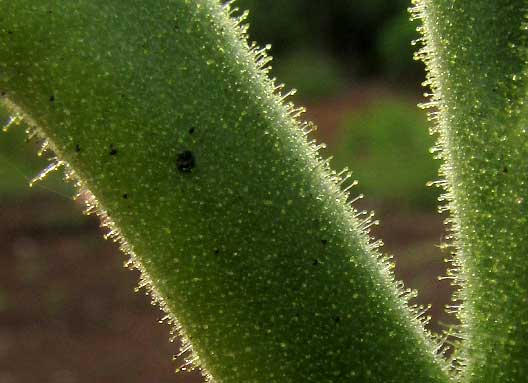
Around here from time to time you see one or two Tobacco plants in people's yards. Mostly it's grown as a novelty, or because it's a handsome plant, but my Maya friends also tell me that certain people smoke and/or chew their leaves, though I can't visualize the curing process properly taking place in this climate, or how you'd smoke or chew uncured tobacco. Curing consists of having the hung-up plant pass through several cycles of drying out and becoming moist, in the process turning from a green plant to one displaying the rich, brown "tobacco color."
Without my family's income from growing tobacco, I'm not sure I'd ever been able to go to college. However, without tobacco, maybe some close members of my family -- smokers, all -- still would be alive. It's a beautiful plant, but I despise the notion of smoking or chewing it.
Our Tobacco plant, Nicotiana tabacum, is just one of numerous Nicotiana species. In Mexico's uplands we've seen Tree Tobacco growing wild. You might enjoy seeing what that looked like at www.backyardnature.net/mexnat/tree-tob.htm
from the April 24, 2016 Newsletter issued from Hacienda Chichen Resort beside Chichén Itzá Ruins; limestone bedrock; elevation ~39m (~128ft), N20.675°, W88.569°; central Yucatán state, MÉXICO
TOBACCO SEEDS
Nowadays on the tobacco plant in the Hacienda's organic garden the flowers' ovaries have matured into brown, capsular fruits that are splitting open and releasing prodigious numbers of tiny seeds. Opening capsules mostly enveloped by the flowers' old, drying-up calyxes are shown below:
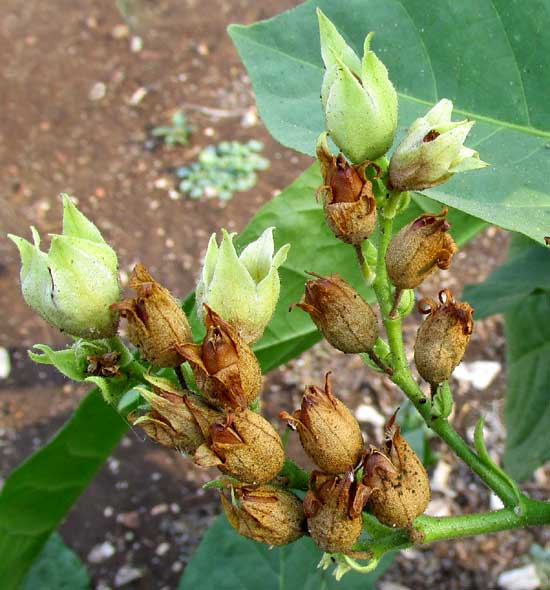
Below, you can see appreciate the seeds' tininess in a photo of the palm of my hand where I've crushed open a couple of capsules:
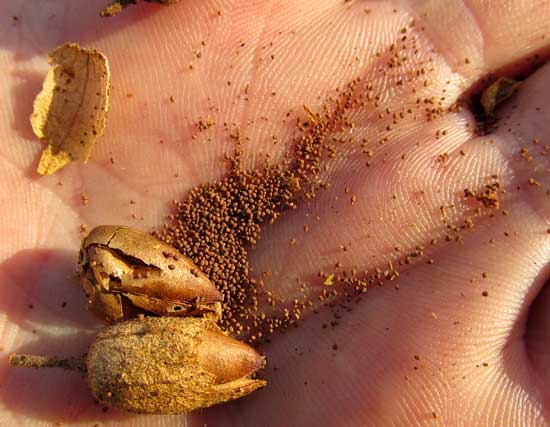
In Nature, big seeds normally are equipped with lots of stored-up endosperm providing food for the embryo that later germinates and might not immediately be able to root where there's adequate water and nutrients, and begin photosynthesizing. Very small seeds don't contain enough endosperm to enable their shoots to survive for long if the seeds germinate in a less-than-perfect environment, so producers of small seeds generally produce many seeds, in the hope that one or a few will survive, and often the seeds germinate only when conditions are optimal. I doubt that any of the many thousands of tobacco seeds being scattered across the garden's floor now will produce new plants, because the ground isn't right for them.
Back on the farm on which I grew up in Kentucky each spring we'd buy packages of tobacco seed and sow them in specially prepared beds. First we'd burn a big pile of wooden slabs salvaged from a local sawmill, the burning sterilizing the soil. Then we'd "broadcast" the seeds across the beds onto the soil's surface, trying to create evenly spaced plants, though always a few spots too thick or thin would develop. Then the bed's surface would be shallowly raked, just enough to jar most seeds into contact with the soil or bury them one or two sandgrains deep. Then we'd water the bed and cover it with thin, white canvas. The canvas was to keep the air atop the beds moist and, during the night, warm. As seedlings developed we always watched closely to prevent the plants from drying out or getting too hot or cold.
Once the seedlings were about ankle high we'd transplant them to the fields. Nowadays machines do the setting, but back then we used wooden pegs whittled from Catalpa wood. During tobacco setting time we always had aching backs and muscles. Though we watered every transplanted plant, many always would die, so several transplantings would have to be made.
I'm amazed at how few visitors I show the Tobacco to can identify it without my telling them. Even when I provide the hints that probably no plant on Earth has killed so many people, and that probably I'd never had been able to afford college if this plant hadn't existed, they just can't figure it out.